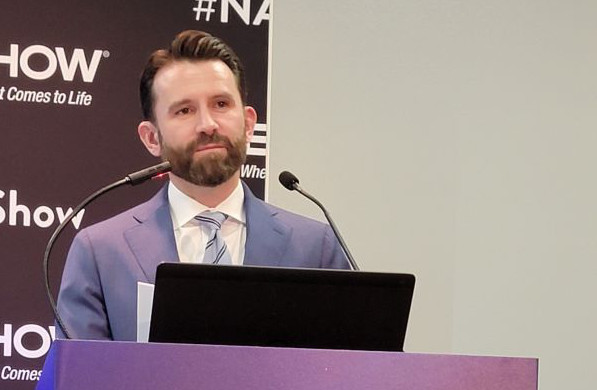Sinclair Provides New Details of Its NextGen TV Plans
Sinclair CEO Chris Ripley and other executives discussed their data casting trial with USSI Global and the rollout of HDR broadcasts to 28 markets using 3.0 broadcasts at the 2022 NAB Show

LAS VEGAS—At the start of the 2022 NAB Show, Sinclair Broadcast Group executives provided a detailed update to their NextGen TV plans, providing new details about their work with USSI Global on a datacasting trial to deliver video and data to electronic vehicle (EV) charging stations, the rollout of HDR broadcasts in 28 markets that have 3.0 signals and a new hybrid broadcast app.
The executives laid out those plans on Saturday April 23 during an 2022 NAB Show press conference at the Las Vegas Convention Center.
“Our industry has reinvented itself to have a seat at the data distribution table,” said Chris Ripley, president and CEO of Sinclair, referring to the transition to the IP-based NextGen TV standard.
The trial with USSI Global will begin in West Palm Beach, Fla., with two charging stations equipped to receive and display “curated, targeted and unique programming” delivered over the air via NextGen TV, said Ripley.
The federal government has a goal of completing national deployment of EV charging stations by 2035 and has allocated billions of dollars to the effort.
USSI Global is hoping to leverage the local presence of Sinclair stations, local content reformatted for the kiosks and the relationships broadcasters have with local advertisers to one day generate new OTA-derived revenue, said Ted Korte, vice president of technology and engineering at USSI Global.
“Imagine you have a display on the street that tells you what’s going on,” said Korte, adding that the trial is intended to learn what is the best way to go forward with how the kiosks could be used nationally. “…[W]e are pretty excited about it.”
Get the TV Tech Newsletter
The professional video industry's #1 source for news, trends and product and tech information. Sign up below.
Central to a national deployment is a core network that broadcasters could use to distribute data from market-to-market, said Ripley.
Local stations would use the network to enable a national footprint for data delivery while maintaining their free OTA telecasts.
Sinclair has been working on such a network internally for a decade, said Mark Aitken, vice president of Advanced Technology at Sinclair and president of ONE Media 3.0, adding that ongoing work by the ATSC to lay the groundwork for a core network is attracting interest from “a number of larger players.”
“I think you are going to see over the next two to three months coming out of the ATSC a blossoming of that activity to develop a core network for not just television broadcast but a data flow.”
Broadcast App and More
Sinclair also announced it is making its broadcast app development toolset available for free with an open license “to all that require it,” said Ripley.
A broadcast app is considered critical to enabling interactivity on fixed and mobile devices, he said.
“We want a common approach to integrating our services with other broadcasters. Having a common broadcast app that all users can help refine is a most efficient way to proceed, and we are happy to provide the seeds to that process,” he said.
Holding up a mobile phone, Ripley also discussed efforts to bring 3.0 to wireless phones. An ongoing trial in Bangalore, India, is examining the direct-to-mobile capabilities of NextGen TV, he said.
Sinclair, which has a financial stake in Saankhya Labs, maker of 3.0 receiver chips, also highlighted the acquisition of a controlling interest in the lab by Tejas Networks, which is owned by Tata Motors.
“It [Saankhya Labs] now has enormous resources of a premiere international company that recognizes the promise of NextGen and the benefits to the Indian market,” he said.
Aiken also touted HDR broadcasts as another selling point for NextGen TV broadcasting, noting that those HDR broadcasts were already available in 28 markets where NextGen TV signals have been launched.
“The ability to offer differentiated content on the 3.0 that a platform is one of its primary advantages,” said Aiken. “There are many things we're doing here, but one example is the work that we're doing with respect to HDR with advanced HDR by Technicolor. The reason we're doing that is so that we can bring a substantially increased viewing experience to the television programming that we can offer. We've got activities going on, coupled with Bally Sports with respect to HDR. Today there are 28 markets offering that today, 3.0 markets that are offering HDR content. So the ability to provide differentiated content, better content, broadcast that providing more engagement, more stickiness, to the nature of the programming is going to drive” a lot of interest.
Phil Kurz is a contributing editor to TV Tech. He has written about TV and video technology for more than 30 years and served as editor of three leading industry magazines. He earned a Bachelor of Journalism and a Master’s Degree in Journalism from the University of Missouri-Columbia School of Journalism.

